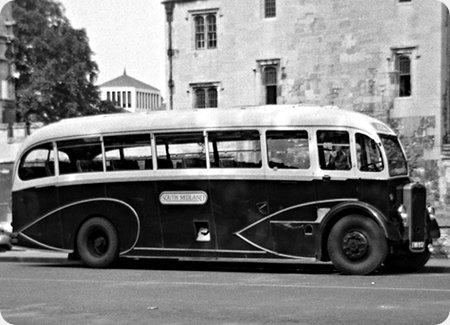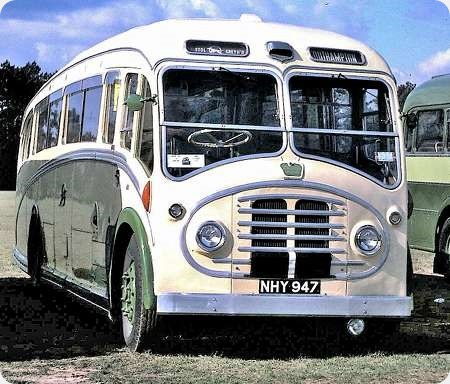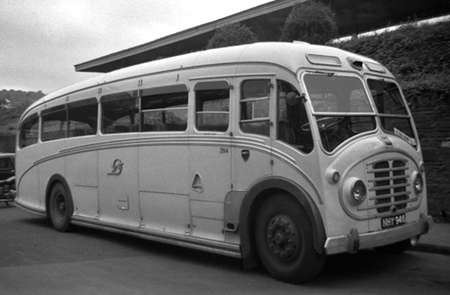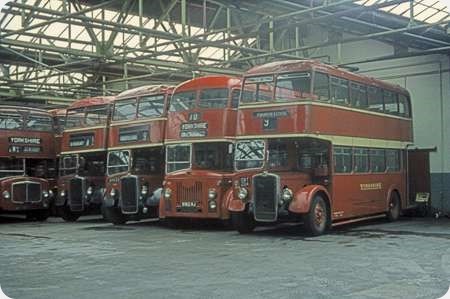South Midland – Bristol L – FMO 937
South Midland Ltd (Witney)
1950
Bristol L6B
Windover C33F
Photographed in Oxford in the summer of 1960 is South Midland Ltd. FMO 937, a Bristol L6B of 1950 with a Windover ‘Huntingdon’ C33F body. Windover was a very old established firm that was known as a saddler and harness maker in Ottery St Mary from the year 1600. The family later became carriage builders, moving first to Grantham and then, in 1856, to Huntingdon where, by the 1920s, it became one of the largest employers in the town. Manufacturing premises held by other members of the Windover family in Manchester and Bradford were acquired in 1893. Production transferred in 1924 to Hendon until the firm sold out to the car dealers Henley in 1956. South Midland was a subsidiary of Thames Valley, with whom this coach first entered service as No. 555 in July 1950 before passing to South Midland some nine years later. It didn’t stay long at Witney, for, by October 1960, it was back with Thames Valley for a further year until withdrawal in October 1961. The following month it was sold to the Hampshire firm, Creamline of Borden, its subsequent fate being unrecorded.
Photograph and Copy contributed by Roger Cox
29/01/17 – 07:11
I had forgotten Windover had supplied Thames Valley/ South Midland with coaches on Bristol Chassis. Other outside coach bodies on Bristol L and LL I can think of at the time were Western ANd Southern National- Beadle and Duple. Hants & Dorset/ Wilts and Dorset Portsmouth Aviation and United Automobile Services Harrington; can anyone think of any more?
Stephen Allcroft
29/01/17 – 08:45
Interesting post, Roger. Thank you. I think Borden relates to a chemical company and that you mean Bordon, in Longmoor Military Railway territory.
Wandering, nay running, wildly off-topic, there is a roundabout at the junction of A27 and B3397 (Hamble Lane) which is officially Windhover Roundabout. Note the H. In this context it means a Kestrel. Does anyone know or have any ideas about the meaning in the coach builder’s context?
Pete Davies
29/01/17 – 09:48
Six Eventful Generations
Bartholomew WINDOVER was a bespoke saddler and harness maker working and living in the town with his wife Mary.
From 1633 when Bartholomew was born to 1796 when Charles James Windover died, six generations of the family lived through some of the most exciting times in British history.
More here:- www.windovers.co.uk/default.htm
John Lomas
29/01/17 – 11:27
I have a model of this vehicle in North Western Road Car Company livery.
Richard Hill
30/01/17 – 07:12
Should have added the fleet number, 270, and the registration DDB 270.
Richard Hill
30/01/17 – 07:13
Yes, Pete, it’s a typo. I mean Bordon – at one period in my varied transport career I regularly drove Aldershot & District Loline IIIs through there on the Aldershot – Petersfield – Steep route 6. One of the prominent figures in the Southampton based group of the Institute of Transport when I was a member in the 1960s and ’70s was Brigadier Nightingale of Longmoor Camp and its railway.
Roger Cox
31/01/17 – 07:25
I don’t think the reference to "South Midland Ltd (Witney)" is quite right. This was the organisation set up in the mid 1980’s when NBC split the Oxford-South Midland business into two parts.
In 1960 FMO 973 would be owned by South Midland Motor Services Ltd. This company had been part of the Red & White group and in 1950, on nationalisation, passed to the control of Thames Valley along with Venture and Newbury & District.
The head office became Thames Valley’s in Reading and South Midland ran out of depot premises in Oxford.
Mike Grant
01/02/17 – 07:31
Withdrawn by Creamline in 1963, presumably for scrap.
Philip Lamb
01/02/17 – 07:31
For about three years, from 1961 to 1964, I lived in Southsea, but worked in Guildford. Every morning, the 07.06 slow electric train from Fratton would stop at Liss Station and on the other side of the platform would be anything from a WD Black 5 to a modest saddle tank loco pulling just two coaches with army/civilian staff who were changing trains for Bordon.
What a comedown for such powerful locos as Black 5’s!
Chris Hebbron
22/04/22 – 06:53
Mike Grant is right about the South Midland company name in the 1960s. These Windover bodied L6B coaches were eleven in total, FMO 20 -26, FMO 934- 937, fleet nos. 545-555, and they were delivered to Thames Valley between March and July 1950. Two, nos. 548/53 went to South Midland in January 1955, but 548 was returned to Thames Valley in October 1958. Another six, nos. 545/50/51/52/54/55, were transferred to South Midland in June/July 1960, but six were sold out of service in October 1960, with just no. 551 FMO 26, lingering on until November 1961. These all went on with other operators to give further service for up to seven years. FMO 937 no. 555 was sold by Creamline in November 1963, and it was last recorded with a Macclesfield dealer in April 1965. However, four of these Windover coaches, FMO 21 – 24 were retained by Thames Valley, who scrapped the bodies, lengthened the chassis in house and replaced the Bristol AVW engines with Gardner 5LWs, thereby transforming them into the LL5G type. These were fitted with new ECW FB39F bodies carrying the garish radiator of the time and re-entered service in February 1959 as nos. 817 – 820. Their extended lives with Thames Valley came to an end between March and July 1968. FMO 21 went briefly to Elm Park Coaches of Romford before passing to Continental Pioneer in August 1968, being finally withdrawn in March 1973. FMO 22 passed to Rossmore Bus Company of Sandbanks who kept it until September 1972. FMO 23 was bought by R Hughes-Jones of Rhostryfan, but, in October 1970, it passed to E W Thomas of Upper Llandwrog who kept it until March 1975. FMO 24 was sold to F G Wilder of Feltham who disposed of it to Norths the dealer in December 1971. It then went to a Leeds contractor, H O Andrews who returned it to Norths in March 1975. Thus some of these machines, albeit in modified form, gave a creditable service life of up to 25 years. I acknowledge the remarkable Thames Valley history by Paul Lacey, the South Midland book by David Flitton and the bristolsu website as the sources of this detail.
Roger Cox
Quick links to the - Comments Page - Contact Page - Home Page




